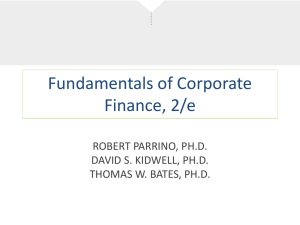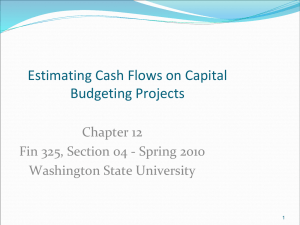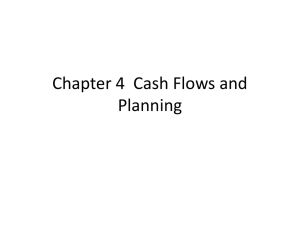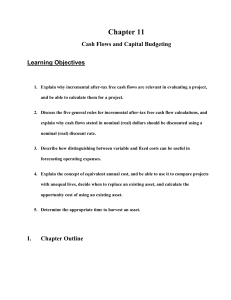Answers to Before You Go On Questions
advertisement
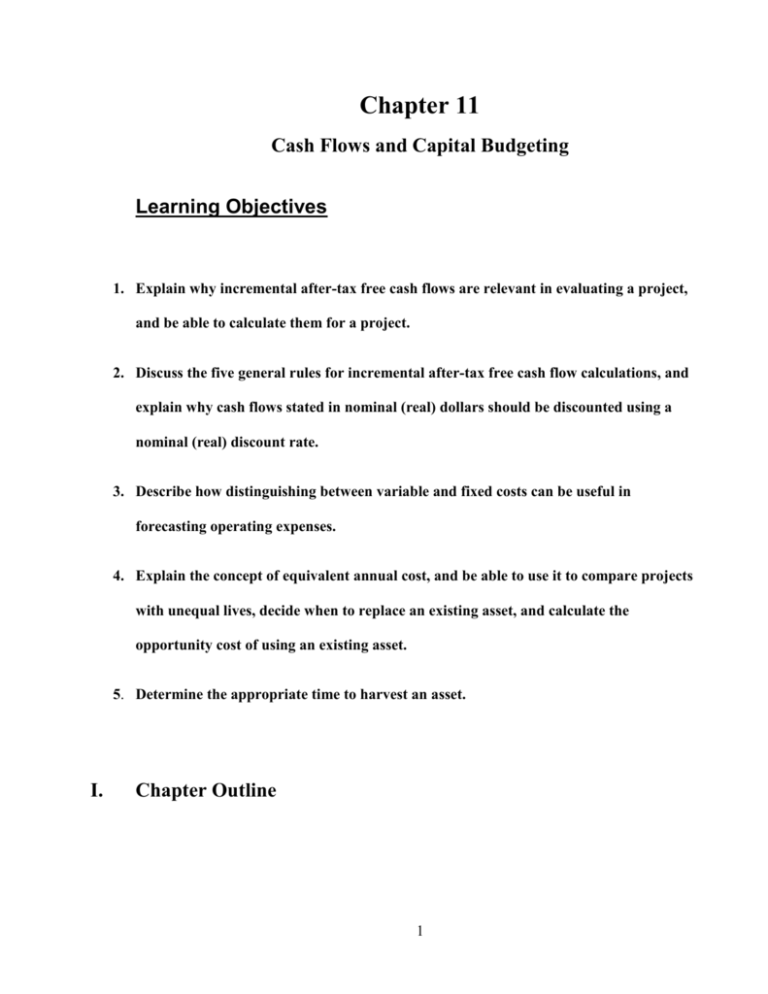
Chapter 11 Cash Flows and Capital Budgeting Learning Objectives 1. Explain why incremental after-tax free cash flows are relevant in evaluating a project, and be able to calculate them for a project. 2. Discuss the five general rules for incremental after-tax free cash flow calculations, and explain why cash flows stated in nominal (real) dollars should be discounted using a nominal (real) discount rate. 3. Describe how distinguishing between variable and fixed costs can be useful in forecasting operating expenses. 4. Explain the concept of equivalent annual cost, and be able to use it to compare projects with unequal lives, decide when to replace an existing asset, and calculate the opportunity cost of using an existing asset. 5. Determine the appropriate time to harvest an asset. I. Chapter Outline 1 11.1 Calculating Project Cash Flows In capital budgeting, we estimate the NPV of the cash flows that a project is expected to produce in the future. A. All of the cash flow estimates are forward-looking. Incremental After-Tax Free Cash Flows The cash flows we discount in an NPV analysis are the incremental after-tax free cash flows , which refers to the fact that these cash flows reflect the amount by which the firm’s total after-tax free cash flows will change if the project is adopted. See Equation 11.1: o FCFProject = FCFFirm with project – FCFFirm without project The term free cash flows (FCF) refers to the fact that the firm is free to distribute these cash flows to creditors and stockholders because these are the cash flows that are left over after a firm has made necessary investments in working capital and long-term assets. B. The FCF Calculation Referring to 11.2, which is a more detailed version of 11.1: FCF = [(Revenue – Op Exp – D&A) x (1 – t)] + D&A – Cap Ex – Add WC We first compute the incremental cash flow from operations (CF Opns), which is the cash flow that the project is expected to generate after all operating expenses and taxes have been paid. We then subtract the incremental capital expenditures (Cap Ex) and incremental additions to working capital (Add WC) required for the project to obtain FCF. 2 The FCF is therefore a measure of the after-tax cash flows from operations over and above what is necessary to make any required investments. The idea that we can evaluate the cash flows from a project independently of the cash flows for the firm is known as the stand-alone principle. It is another way of saying that we can treat the project as if it is a stand-alone firm that has its own revenue, expenses, and investment requirements. C. Cash Flows from Operations Note that the incremental cash flow from operations, CF Opns, equals the incremental net operating profits after tax (NOPAT) plus the incremental depreciation and amortization (D&A) associated with the project. We exclude interest expenses when calculating NOPAT because the cost of financing a project is reflected in the discount rate that is used in the NPV calculation. We use the firm’s marginal tax rate (t) to calculate NOPAT because the profits from a project are assumed to be incremental to the firm. We add incremental depreciation and amortization (D&A) to NOPAT when calculating CF Opns because, as in the accounting statement of cash flows, D&A represents a noncash charge that reduces the firm’s tax obligation. However, since D&A is a noncash charge, we have to add it back to NOPAT in order to get the cash flow from operations right. D. Cash Flows Associated with Investments Once we have estimated CF Opns, we simply subtract cash flows associated with required investment to obtain FCF for a project in a particular period. 3 Investments can be required to purchase long-term tangible assets and intangible assets, or to fund current assets. E. FCF versus Accounting Earnings The impact of a project on a firm’s overall value or on its stock price does not depend on how the project affects the company’s accounting earnings. It depends only on how the project affects the company’s free cash flows. Accounting earnings can differ from cash flows for a number of reasons, making accounting earnings an unreliable measure of the costs and benefits of a project. Accounting earnings also reflect noncash charges, such as depreciation and amortization, which are intended to account for the costs associated with deterioration of the assets in a business as those assets are used. 11.2 Estimating Cash Flows in Practice A. Five General Rules for Incremental Cash Flow Calculations Rule 1: Include cash flows and only cash flows in your calculations. Do not include allocated costs or overhead unless they reflect cash flows. Rule 2: Include the impact of the project on cash flows from other product lines. If the product associated with a project is expected to cannibalize or boost sales of another product, you must include the expected impact of the new project on the cash flows from the other product in the analysis. Rule 3: Include all opportunity costs. By opportunity costs, we mean the cost of giving up another opportunity. 4 Rule 4: Forget sunk costs. Sunk costs are costs that have already been incurred, but all that matters when you evaluate a project at a particular point in time is how much you have to invest in the future and what you could expect to receive in return for that investment; this means that past investments are irrelevant. Rule 5: Include only after-tax cash flows in the cash flow calculations. The incremental pretax earnings of a project only matter to the extent that they affect the after-tax cash flows that the firm’s investors receive. B. Nominal versus Real Cash Flows Nominal dollars are the dollars that we typically think of. They represent the actual dollar amounts that we expect a project to generate in the future, without any adjustments. When prices are going up, a given nominal dollar amount will buy less and less over time. o Real dollars represent dollars stated in terms of constant purchasing power. We can write the cost of capital , k, as o 1 + k = (1 + ∆Pe) x (1 + r) r is the real cost of capital (∆Pe) is the expected rate of inflation (r) is the real rate of return It is important to make sure that all cash flows are stated in either nominal dollars or real dollars. C. Tax Rates and Depreciation 5 A progressive tax system, which we have in the United States, is one in which the marginal tax rate at low levels of income is lower than the marginal tax rate at high levels of income. One especially important difference from a capital budgeting perspective is that the depreciation methods allowed by GAAP differ from those allowed by the IRS. o The straight-line depreciation method illustrated earlier in this chapter in the NASCAR racetrack example is allowed by GAAP and is often used for financial reporting. o An “accelerated” method of depreciation, called the Modified Accelerated Cost Recovery System (MACRS), has been in use for U.S. federal tax calculations since the Tax Reform Act of 1986 went into effect. MACRS thus enables a firm to deduct depreciation charges sooner, thereby realizing the tax savings sooner and increasing the present value of the tax savings. D. Computing the Terminal-Year FCF The FCF in the last, or terminal, year of a project often includes cash flows that are not typically included in the calculations for other years. o For instance, in the final year of a project, the assets acquired during the life of the project may be sold and the working capital that has been invested may be recovered. Add WC = Change in cash and cash equivalents + Change in accounts receivable + Change in inventories – Change in accounts payable. 6 o When an asset is expected to have a salvage value, we must include the salvage value realized from the sale (net of any tax consequences) of the asset and the impact of the sale on the firm’s taxes in the terminal-year FCF calculations. E. Expected Cash Flows We are estimating when we forecast FCF in an NPV analysis. o The expected FCF for a particular year equals the sum of the products of the possible outcomes (FCFs) and the probabilities that those outcomes will be realized. 11.3.1 Forecasting Free Cash Flows A. Cash Flows from Operations To forecast incremental cash flows from operations we must forecast the incremental net revenue, operating expenses, and depreciation and amortization associated with the project, as well as the firm’s marginal tax rate When forecasting operating expenses, analysts often distinguish between variable costs and fixed costs B. Investment Cash Flows We must consider two general classes of investments when calculating FCF: incremental capital expenditures and incremental additions to working capital 1. Capital Expenditures o Capital expenditure forecasts in an NPV analysis reflect the expected level of investment during each year of the project’s life. 7 o Capital expenditures are typically required at the beginning of a project 2. Working Capital o Cash flow forecasts in an NPV analysis include four working capital items: 1)cash and cash equivalents, 2) accounts receivable, 3) inventories, and 4) accounts payable 11.4 Special Cases A. Projects with Different Lives A problem that arises quite often in capital budgeting involves choosing between two mutually exclusive investments where the investments have different lives. o In a situation like this, we can effectively make the lives of the mowers the same by assuming repeated investments over some identical period and then comparing the NPVs of their costs. o A less cumbersome and more powerful method to handle the problem is to compute the equivalent annual cost (EAC). The EAC can be calculated as follows: EACi = kNPVi [(1 + k)t / (1 + k)t –t 1] 1 k EACi k NPVi t 1 k 1 (11.5) k is the opportunity cost of capital NPVi is the normal NPV of the investment i t is the life of the investment EAC simply reflects the annuity that has the same present value as the ∆FCFs of an investment over the investment period we are considering. 8 B. When to Harvest an Asset The optimal time to harvest is the point in time at which the rate of increase in cash flows, from period to period, is no longer greater than the cost of capital. At this point in time, it becomes optimal to harvest the trees and invest the proceeds in alternative investments that yield the opportunity cost of capital. C. When to Replace an Existing Asset Two fundamental questions: Do the benefits of replacing the existing asset exceed the costs, and, if they do not now, when will they? Solving this problem is simply a matter of computing the EAC for the new asset and comparing it with the annual cash inflows from the old asset. D. The Cost of Using an Existing Asset The third rule of calculating incremental after-tax cash flows is to include all opportunity costs that are not always directly observable. o Sometimes they have to be computed by first figuring the EAC for a given set of cash flows and then adjusting the EAC by the appropriate discount rate and time, if the EAC is not in present value form. 9 10


